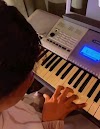### Using the Pitch Bend Wheel on Yamaha PSR Series Keyboards
The pitch bend wheel on Yamaha PSR series keyboards allows you to change the pitch of the notes you're playing in real time. This feature is commonly used to add expressiveness to performances, especially for emulating instruments like guitar, saxophone, and other solo instruments where pitch variation is natural. Here’s a guide on how to use the pitch bend function effectively.
#### Understanding the Pitch Bend Wheel
The pitch bend wheel is usually located on the left side of the keyboard, near the modulation wheel or joystick. It is a spring-loaded wheel that returns to its center position when released.
- **Upwards Movement**: Bends the pitch up.
- **Downwards Movement**: Bends the pitch down.
- **Center Position**: No pitch change.
#### Step-by-Step Guide to Using the Pitch Bend Wheel
1. **Locate the Pitch Bend Wheel**:
- Find the pitch bend wheel on the left side of your Yamaha PSR keyboard.
2. **Selecting a Suitable Voice**:
- Pitch bend is most effective with certain voices such as lead synths, guitars, brass, strings, and woodwinds. Select a voice that benefits from pitch bending.
- Example: Select a `Lead Synth` or `Electric Guitar` voice using the `VOICE` button and navigation controls.
3. **Using the Pitch Bend Wheel**:
- While playing a note or chord with your right hand, use your left hand to manipulate the pitch bend wheel.
- **Push the Wheel Up**: To raise the pitch of the notes.
- **Pull the Wheel Down**: To lower the pitch of the notes.
- **Release the Wheel**: It will spring back to the center position, returning the pitch to normal.
4. **Experimenting with Pitch Bend Range**:
- Some Yamaha PSR models allow you to adjust the pitch bend range. This defines how much the pitch will change when you move the wheel to its extremes.
- Access the `FUNCTION` menu, navigate to `Pitch Bend Range`, and adjust the range (e.g., 2 semitones up and down).
#### Examples of Using Pitch Bend in Performance
**Example 1: Guitar Solo**
- **Voice**: Electric Guitar
- **Usage**: Mimic guitar techniques like bends and slides by pushing the pitch bend wheel up for upward bends and down for downward bends.
**Example 2: Saxophone Expression**
- **Voice**: Tenor Saxophone
- **Usage**: Add expressiveness to your saxophone lines by slightly bending the pitch up or down, mimicking the natural variations of a wind instrument.
**Example 3: Synth Lead**
- **Voice**: Lead Synth
- **Usage**: Create dramatic pitch slides and swoops in electronic music by moving the pitch bend wheel smoothly while playing notes.
**Example 4: Violin Portamento**
- **Voice**: Solo Violin
- **Usage**: Use the pitch bend wheel to add realistic portamento effects, sliding between notes as a violinist would.
#### Tips for Effective Use
- **Subtle Movements**: Sometimes, subtle pitch bends are more effective than large ones. Small adjustments can add a lot of expressiveness without being too obvious.
- **Practice**: Get comfortable with using the pitch bend wheel by practicing scales and simple melodies, incorporating pitch bends at various points.
- **Combine with Modulation**: For even more expressiveness, use the pitch bend wheel in combination with the modulation wheel or joystick, which can add vibrato or other effects.
- **Experiment with Different Voices**: Not all voices respond to pitch bend in the same way. Experiment with different voices to see which ones produce the most musical and pleasing results.
Don't forget to share and follow me.










0 Comments